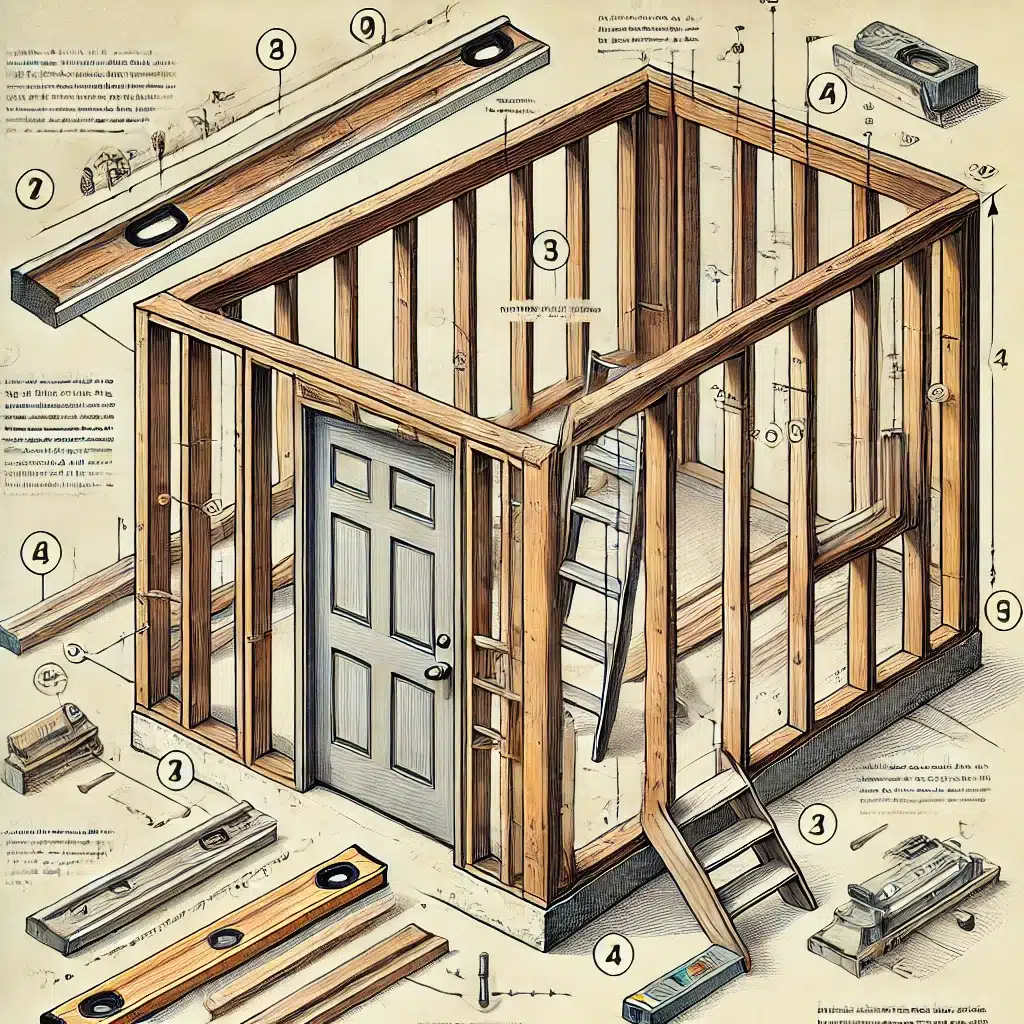Framing a garage door is not just about creating a structure for the door to fit into; it’s about ensuring the stability, security, and longevity of your entire garage door system. Proper framing provides the necessary support to handle the weight and movement of the door, preventing issues such as sagging, misalignment, or even structural damage over time. Whether you’re constructing a new garage from scratch or upgrading an existing setup, getting the framing right is the foundation for a successful installation that will keep your garage door operating smoothly for years to come.
In addition to its functional importance, precise framing also contributes to the overall aesthetic appeal of your garage door. A well-framed garage door enhances curb appeal by ensuring the door fits perfectly within the space, with clean lines and no gaps. This not only improves the look of your home but also helps with insulation and weatherproofing, keeping your garage secure and energy-efficient. In this guide, we’ll provide detailed, step-by-step instructions to help you frame your garage door with the expertise of a seasoned professional, ensuring a perfect fit and finish.
Importance of Proper Garage Door Framing
Proper garage door framing is not just about aesthetics; it plays a vital role in the overall functionality and safety of your garage. A well-framed opening ensures the door’s weight is evenly distributed, preventing sagging or misalignment over time. Additionally, a sturdy frame helps to maintain the door’s structural integrity, protecting against potential damage from high winds or other external forces. By following the right framing techniques, you can ensure your garage door operates smoothly, enhances the curb appeal of your home, and provides a secure and reliable entryway.
Tools and Materials Needed for Framing a Garage Door
Before you begin the framing process, it’s important to gather the necessary tools and materials. Here’s a list of what you’ll need:
- Tape measure
- Level
- Circular saw or miter saw
- Power drill with drill bits
- Hammer
- Pry bar
- Clamps
- Lumber (e.g., 2x4s, 2x6s)
- Screws or nails
- Concrete anchors (if attaching to a concrete wall)
- Shims (if needed)
Ensure you have all the required items on hand before starting the project to avoid any delays or interruptions.
Step 1: Measuring and Marking the Opening for the Garage Door
The first step in framing a garage door is to accurately measure and mark the opening. Start by measuring the width and height of the existing or desired garage door opening. Make sure to measure at the top, middle, and bottom of the opening to ensure it’s square and level. Once you have the measurements, use a pencil or marker to clearly mark the boundaries of the opening on the wall.
Step 2: Installing the Header and Jack Studs
The header is the horizontal beam that spans the top of the garage door opening and supports the weight of the door. To install the header, measure the width of the opening and cut a 2×6 or 2×8 lumber piece to fit snugly within the opening. Position the header at the top of the opening and secure it in place using screws or nails.
Next, install the jack studs, which are the vertical supports that hold the header in place. Measure the height of the opening and cut two pieces of 2×4 or 2×6 lumber to fit. Position the jack studs at the outer edges of the opening, aligning them with the header, and secure them to the wall using screws or nails.
Step 3: Adding the King Studs and Cripple Studs
The king studs are the vertical support posts that run the full height of the garage door opening, from the bottom of the header to the floor. Measure the height of the opening and cut two pieces of 2×4 or 2×6 lumber to fit. Position the king studs at the outer edges of the opening, aligning them with the jack studs, and secure them in place.
The cripple studs are the shorter vertical supports that fill the space between the header and the top of the garage door opening. Measure the distance between the header and the top of the opening, and cut 2×4 or 2×6 lumber pieces to fit. Secure the cripple studs in place between the king studs and the header.
Step 4: Installing the Horizontal and Vertical Tracks
The horizontal and vertical tracks are the metal rails that guide the garage door as it opens and closes. Start by attaching the vertical tracks to the king studs, ensuring they are plumb (perfectly vertical) and securely fastened. Then, install the horizontal tracks, aligning them with the top of the opening and securing them to the header.
Step 5: Attaching the Brackets and Rollers
With the tracks in place, it’s time to attach the brackets and rollers that will support the garage door panels. Follow the manufacturer’s instructions for the specific placement and installation of these components, ensuring they are properly aligned and tightened.
Step 6: Mounting the Garage Door Panels
Once the framing and tracking system is in place, you can begin mounting the garage door panels. Start by positioning the bottom panel and securing it to the brackets and rollers. Continue adding the remaining panels, making sure they are properly aligned and that the door operates smoothly as it opens and closes.
Step 7: Installing the Springs and Cables
The garage door’s spring and cable system is responsible for counterbalancing the weight of the door, making it easy to open and close. Follow the manufacturer’s instructions for installing the springs and cables, ensuring they are properly tensioned and secured.
Step 8: Testing and Adjusting the Garage Door
After completing the installation, it’s essential to test the garage door’s operation and make any necessary adjustments. Ensure the door opens and closes smoothly, without binding or excessive resistance. If you encounter any issues, refer to the manufacturer’s troubleshooting guide or consult a professional for assistance.
Common Mistakes to Avoid When Framing a Garage Door
To ensure a successful garage door framing project, it’s important to avoid the following common mistakes:
- Inaccurate measurements
Carefully measure the opening to ensure the framing components fit properly.
- Improper alignment
Make sure the header, jack studs, and king studs are perfectly aligned and plumb.
- Insufficient bracing
Failing to properly brace the framing can lead to sagging or instability over time.
- Incorrect track installation
Improperly installed tracks can cause the door to bind or operate unevenly.
- Overlooking safety
Always prioritize safety by wearing protective gear and following the manufacturer’s instructions.
FAQs
What is the rough opening for garage door framing?
The rough opening for garage door framing should be the same width and height as the garage door itself, allowing for the door to fit snugly within the frame while leaving enough space for the door tracks and hardware. Typically, you should add 1.5 to 2 inches to the width and height of the door to accommodate the framing material, ensuring a secure and well-supported installation.
What is the rough opening for a 9×7 garage door?
For a 9×7 garage door, the rough opening should be 9 feet wide by 7 feet high, matching the exact dimensions of the door to provide a proper fit. This allows for the necessary clearance for installation and ensures the door operates smoothly within the frame.
What is the size of a garage door frame?
The size of a new garage door frame typically corresponds to the dimensions of the garage door, with the frame being slightly larger to accommodate the door itself and the necessary hardware. For example, a standard 9×7 garage door frame would need to be approximately 9 feet 3 inches wide by 7 feet 1.5 inches high, accounting for the framing material and any additional space required for installation.
What is the best material for a garage door jamb?
The best material for a garage door jamb is pressure-treated wood, as it is durable, resistant to moisture, and less prone to warping or rotting compared to untreated wood. Alternatively, composite materials or PVC can also be used, offering long-lasting performance with minimal maintenance, especially in areas prone to extreme weather conditions.
What is the spacing for garage doors?
The spacing between two garage doors should typically be at least 12 to 18 inches to allow enough room for the door tracks, hardware, and framing, as well as to provide structural integrity to the wall separating the doors. This spacing also ensures that each door operates independently without interference, contributing to the overall functionality and safety of your garage.
Which would be the correct size of a garage door?
The correct size of a garage door depends on the specific needs of your garage and vehicle storage; common residential garage door sizes range from 8×7 feet for single-car garages to 16×7 feet or larger for double-car garages. To determine the best size, consider the width and height of the vehicles you plan to store, along with any additional clearance needed for easy access and maneuverability.
Conclusion
At Perfect Solutions Garage Door, we understand that framing your garage door correctly is crucial to the overall performance and appearance of your garage. A well-framed garage door not only ensures that the door operates smoothly and efficiently but also plays a vital role in maintaining the structural integrity of your garage. By following the proper framing techniques, you can avoid common issues like sagging, misalignment, and damage, which can lead to costly garage door repairs down the road. Our step-by-step guide is designed to equip you with the knowledge and confidence to frame your garage door like a professional, ensuring that your door remains stable, secure, and durable for years to come.
Beyond functionality, the aesthetics of your garage door are significantly enhanced when it is framed correctly. A perfectly framed door fits seamlessly within its opening, contributing to the overall curb appeal of your home. This not only adds value to your property but also ensures that your garage is well-insulated and protected against the elements. At Perfect Solutions Garage Door, we believe that every detail matters and proper framing is the key to achieving a flawless finish that complements your home’s style while providing the necessary protection and efficiency.
If you’re considering a new garage door installation or need to upgrade an existing frame, Perfect Solutions Garage Door is here to help. Our team of experts is dedicated to delivering high-quality results, ensuring that every aspect of your garage door, from framing to installation, is handled with precision and care. Trust us to provide the professional guidance and services you need to achieve a garage door that not only looks great but also performs reliably for years to come.
End Note
Thank you for taking the time to read our guide on how to frame a garage door for a professional finish. At Perfect Solutions Garage Door, we’re committed to providing top-quality services that ensure your garage door operates smoothly and looks great. Whether you’re in need of expert installation, repair, or maintenance, we offer a wide range of garage door services to meet your needs.
Our team proudly serves various locations, which you can explore on our service areas page. If you’re curious about the brands we work with, including LiftMaster, or want to see examples of our work, be sure to check out our gallery and garage door brands pages.
To learn more about who we are and what drives our commitment to excellence, visit our About Us page. If you have any questions, need a consultation, or want to schedule a service, don’t hesitate to contact us. Also, stay updated with our latest tips and insights by visiting our blog regularly.
At Perfect Solutions Garage Door, we’re here to help you every step of the way, ensuring your garage door is framed, installed, and maintained to perfection.


